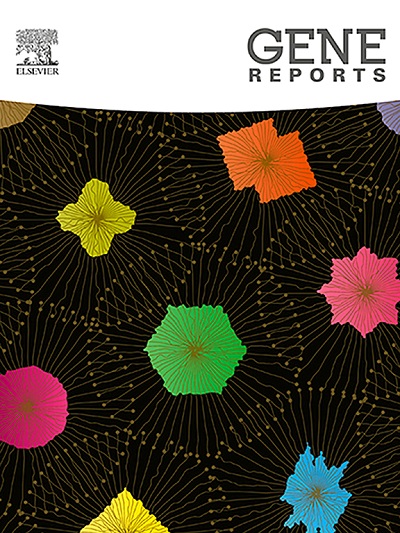A comprehensive study of highly repetitive WD40 proteins in cyanobacteria
IF 1
Q4 GENETICS & HEREDITY
引用次数: 0
Abstract
The WD40 repeat-containing proteins are ancient proteins regulating various cellular and biological processes in eukaryotes. WD40 proteins are extensively studied in eukaryotes, and their genome-wide characterisation has revealed their hidden potential. On the contrary, in-depth taxonomic and functional description of WD40 proteins in prokaryotes, particularly in cyanobacteria, remains largely unexplored. In this study, we have comprehensively analysed cyanobacterial WD40 proteins and detailed comparisons among different cyanobacterial orders. About 7000 WD40 proteins were identified in all six cyanobacterial orders accounting for 22–43 % of all WD40s. While their abundance was less in Chroococcales, Pleurocapsales and, Stigonematales, the WD40s were profoundly present in Nostcales and Oscillatoriales, exhibiting multifarious functions such as cell signalling, transcription factors, catalytic enzymes and scaffold etc. Current systemic analysis showed that most WD40 proteins contain multiple WD40 domains, as indicated by their repeat numbers and average confidence scores. The observation also indicated that most WD40 proteins have complex hydrogen bond networks. Their taxonomic distribution and gene neighbourhood analysis revealed topical or newly repeated duplication events form most WD40s. Further, the studies confirmed that the recently formed WD40 proteins are highly repetitive with higher structural stability. Overall, the result of this study has described an assembly of cyanobacterial WD40 proteins and highlighting their evolution, distribution and probable functions.
蓝藻中高度重复的 WD40 蛋白的综合研究
含 WD40 重复的蛋白质是调节真核生物中各种细胞和生物过程的古老蛋白质。真核生物对 WD40 蛋白进行了广泛的研究,对它们进行的全基因组表征揭示了它们隐藏的潜力。相反,对原核生物(尤其是蓝藻)中的 WD40 蛋白进行深入的分类和功能描述在很大程度上仍是空白。在这项研究中,我们全面分析了蓝藻的 WD40 蛋白,并对不同蓝藻纲之间进行了详细比较。我们在所有六个蓝藻目中鉴定了约 7000 个 WD40 蛋白,占所有 WD40 蛋白的 22-43%。虽然 WD40 蛋白在 Chroococcales、Pleurocapsales 和 Stigonematales 中含量较少,但在 Nostcales 和 Oscillatoriales 中却大量存在,表现出多种功能,如细胞信号、转录因子、催化酶和支架等。目前的系统分析显示,大多数 WD40 蛋白包含多个 WD40 结构域,这一点可以从它们的重复次数和平均置信度得分看出。观察结果还表明,大多数 WD40 蛋白具有复杂的氢键网络。它们的分类分布和基因邻近分析表明,大多数 WD40 蛋白都存在局部或新近重复的复制事件。此外,研究还证实,新近形成的 WD40 蛋白具有高度重复性和较高的结构稳定性。总之,这项研究的结果描述了蓝藻 WD40 蛋白的组合,突出了它们的进化、分布和可能的功能。
本文章由计算机程序翻译,如有差异,请以英文原文为准。
求助全文
约1分钟内获得全文
求助全文
来源期刊

Gene Reports
Biochemistry, Genetics and Molecular Biology-Genetics
CiteScore
3.30
自引率
7.70%
发文量
246
审稿时长
49 days
期刊介绍:
Gene Reports publishes papers that focus on the regulation, expression, function and evolution of genes in all biological contexts, including all prokaryotic and eukaryotic organisms, as well as viruses. Gene Reports strives to be a very diverse journal and topics in all fields will be considered for publication. Although not limited to the following, some general topics include: DNA Organization, Replication & Evolution -Focus on genomic DNA (chromosomal organization, comparative genomics, DNA replication, DNA repair, mobile DNA, mitochondrial DNA, chloroplast DNA). Expression & Function - Focus on functional RNAs (microRNAs, tRNAs, rRNAs, mRNA splicing, alternative polyadenylation) Regulation - Focus on processes that mediate gene-read out (epigenetics, chromatin, histone code, transcription, translation, protein degradation). Cell Signaling - Focus on mechanisms that control information flow into the nucleus to control gene expression (kinase and phosphatase pathways controlled by extra-cellular ligands, Wnt, Notch, TGFbeta/BMPs, FGFs, IGFs etc.) Profiling of gene expression and genetic variation - Focus on high throughput approaches (e.g., DeepSeq, ChIP-Seq, Affymetrix microarrays, proteomics) that define gene regulatory circuitry, molecular pathways and protein/protein networks. Genetics - Focus on development in model organisms (e.g., mouse, frog, fruit fly, worm), human genetic variation, population genetics, as well as agricultural and veterinary genetics. Molecular Pathology & Regenerative Medicine - Focus on the deregulation of molecular processes in human diseases and mechanisms supporting regeneration of tissues through pluripotent or multipotent stem cells.
 求助内容:
求助内容: 应助结果提醒方式:
应助结果提醒方式:


